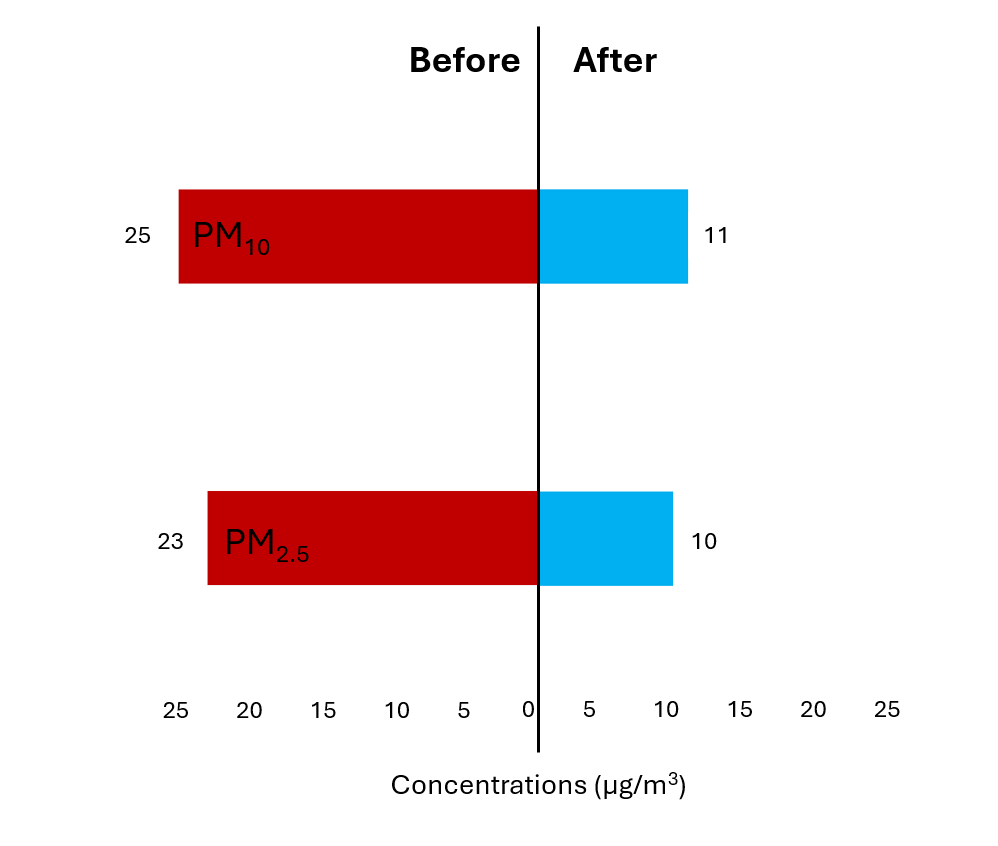Beats for Planet:
Key Findings


3 Years of Beats for Planet: this is what we know about air quality in Belgian schools
If you have been following Airscan for a while, you will definitely know Beats for Planet. Airscan launched this project with Belfius three years ago with the aim of helping schools improve their air quality. In the framework of this project, Airscan has collected and analyzed data from 72 schools around Belgium for three indoor pollutants: carbon dioxide (CO2), particulate matter (PM) and volatile organic compounds (VOC). This is what we found.

Beats for Planet is the result of a collaboration between Airscan and Belfius. The project, launched in 2020, aims to give schools the technological, human and financial means to improve children's health and reduce the climate impact of schools.
Why did you decide to take part in the project?
The importance of monitoring indoor air quality in schools stems from the fact that children attending school on average spend around one-third of their day indoors, 70% of which is within the confines of classrooms. Children are more vulnerable to poor IAQ as compared to adults because they have immature organs, a small lung capacity and higher breathing rates. Bad IAQ can therefore cause negative impacts not only on their respiratory and cardiac health, but also productivity, academic performance and behavior.
Indoor air quality monitoring can cover a very broad range of pollutants and parameters. While developing the concept of the project, the Airscan team decided to focus on 3 main pollutant groups: Carbon dioxide (CO2), Volatile Organic Compounds (VOC) and Particulate Matter (PM). Although carbon dioxide is emitted naturally through expiration, it is essential to monitor this gas for two reasons: first, it helps to understand if a room receives a sufficient fresh air supply and second, high CO2 levels when accumulated in small spaces can cause symptoms such as fatigue, cognitive deficits, and in some cases nausea.
Particulate matter in a school can arise from chalk use, deterioration of building material, art supplies, or re-suspension of deposited particles due to the movement of people or by airflow from the outside. Fine particulate matter can amount to serious health consequences as it can penetrate the physiological barriers in the lungs, leading to respiratory infections and diseases. Volatile organic compound sources are much more difficult to pinpoint, however, they can be emitted by chemical substances such as cleaning products, perfumes, glues and in some cases paints. These toxic compounds are known to be very reactive and contribute to a wide range of adverse health effects, discomfort and lack of focus.
The thresholds for each of the pollutants are taken from different health and safety organisations. For CO2 the threshold of 900ppm is used based on guidelines outlined by SPF Santé Publique, Sécurité de la Chaîne alimentraire et Environnement. For PM2.5 the WHO 2021 threshold of 5 µg/m3 was considered, and finally the VOC limit of 79.6 ppb or 300 μg/m³ was used, based on the Binnenmilieubesluit released by Hoge Gezondheidsraad (the Flemish Belgian Superior Health Council). The thresholds are summarised in the table below:

Project's Scope
The project consists of Airscan technicians installing three indoor devices in different classrooms in each school. A first diagnosis is executed one month after installation to analyse the state of the air quality within those classrooms. A presentation is devised to consult directors, professors or a prevention council on how to reduce concentrations. These suggestions range from developing methods to increase air exchanges to advice on cleaning schedules and product usage. A final check-in is done after 6 months to see if the suggestions took effect. The graphs in Figure 2 show the percentage of schools participating in the project that managed to reduce indoor air pollution concentrations by the end of the campaign.


Average Concentrations
The figure below shows that in most schools, average concentrations after a 6-month campaign remained below the recommended thresholds for carbon dioxide and volatile organic compounds. Specifically, 67% of schools comply with the CO2 thresholds, and 55% of schools comply with the VOCs thresholds. However, for PM2.5, only 16% of schools were found to have average concentrations under the threshold of 5 µg/m³.
What are the average final concentrations for all school?
Reliance on natural ventilation to facilitate fresh air supply is sometimes not enough to keep indoor CO2 concentration under the limit and aid in reducing concentrations of certain pollutants. This especially true in older buildings with few windows that can open, or in small classrooms occupied by many students. Additionally, natural ventilation can lead to the transport of outdoor pollutants into the indoor environment especially in the case of particulate matter which is a significant source of concern. One particularly interesting solution to this is installing a mechanical ventilation system – in which the benefits could be seen in certain classrooms especially for decreasing volatile organic compound concentrations and particulate matter. Decreases due to the installation of a mechanical ventilation system range from 46% for VOC’s, 25% for particulate matter, and 19% for carbon dioxide in the 72 schools studied.

Ventilated vs. Not Ventilated Classrooms
The below mentioned Figure 4 can be proved by the case of one school where a mechanical ventilation system in a classroom was installed two months after the start of the measurement campaign. This classroom showed a dramatic drop in CO2 concentrations when comparing averages before and after the installation (from 1288 ppm to 811 ppm) as well as a 25% decrease in PM’s and a 50% decrease in VOC’s. While the benefits of a mechanical ventilation system are clear looking at these results, it is still important to remember that such systems require maintenance and control.
Maintenance is an important factor in ensuring ventilation systems don’t negatively impact indoor air quality. Clogged filters and dirty ducts can accumulate mold and other debris which would in turn reduce airflow and distribute contaminants throughout the building. Systems additionally need to be properly designed to provide adequate ventilation strategies reaching all areas which can control excess humidity, inconsistent temperatures, and pollutant removal.
While the installation of a mechanical ventilation system can be an investment that would be difficult to foresee in many schools, there exists an alternative, especially for particulate matter accumulation. Air purifiers are an alternative solution in classrooms that may be subject to higher levels of these pollutants. This was the case in one school, where an air purifier was installed at the end of the campaign to aid in decreasing PM2.5 concentrations in a classroom situated next to the woodworking shop.


Air Purifier: Before and After Installation
Figure 5 shows concentrations drop by more than 50% after the installation of the air purifier in the classroom. This case study particularly highlights the importance of a school’s infrastructure in controlling indoor pollution. This ranges from making sure windows function and can be opened to facilitate natural ventilation, to ensuring there is a vacuum effect in workshops so that particles do not escape into other classrooms as is the case here.
This summary reveals several important findings regarding air quality in Belgian schools:
- Particulate matter is a greater concern in Belgian schools compared to carbon dioxide accumulation or volatile organic compounds.
- Mechanical ventilation systems, when installed in classrooms, significantly improve indoor air quality, reducing levels of particulate matter, carbon dioxide, and volatile organic compounds.
- Air purifiers also effectively reduce particulate matter levels, contributing to better indoor air quality.
Latest Articles

School air quality: protect children today | Airscan
Children are more vulnerable to air pollution at school. Key Brussels data, effective measures (school streets, LEZ), and Airscan solutions: monitoring, smart ventilation, certification‑ready reporting.


Ventilation Audits in Flanders Care Homes: Airscan’s 40‑Site Study on Indoor Air Quality
Airscan’s audit of 40 Flemish care homes uncovered critical ventilation issues: nearly 1 in 4 rooms exceeded safe CO₂ limits. With VEB and VIPA support, the study offers data-driven solutions to protect residents’ health.
